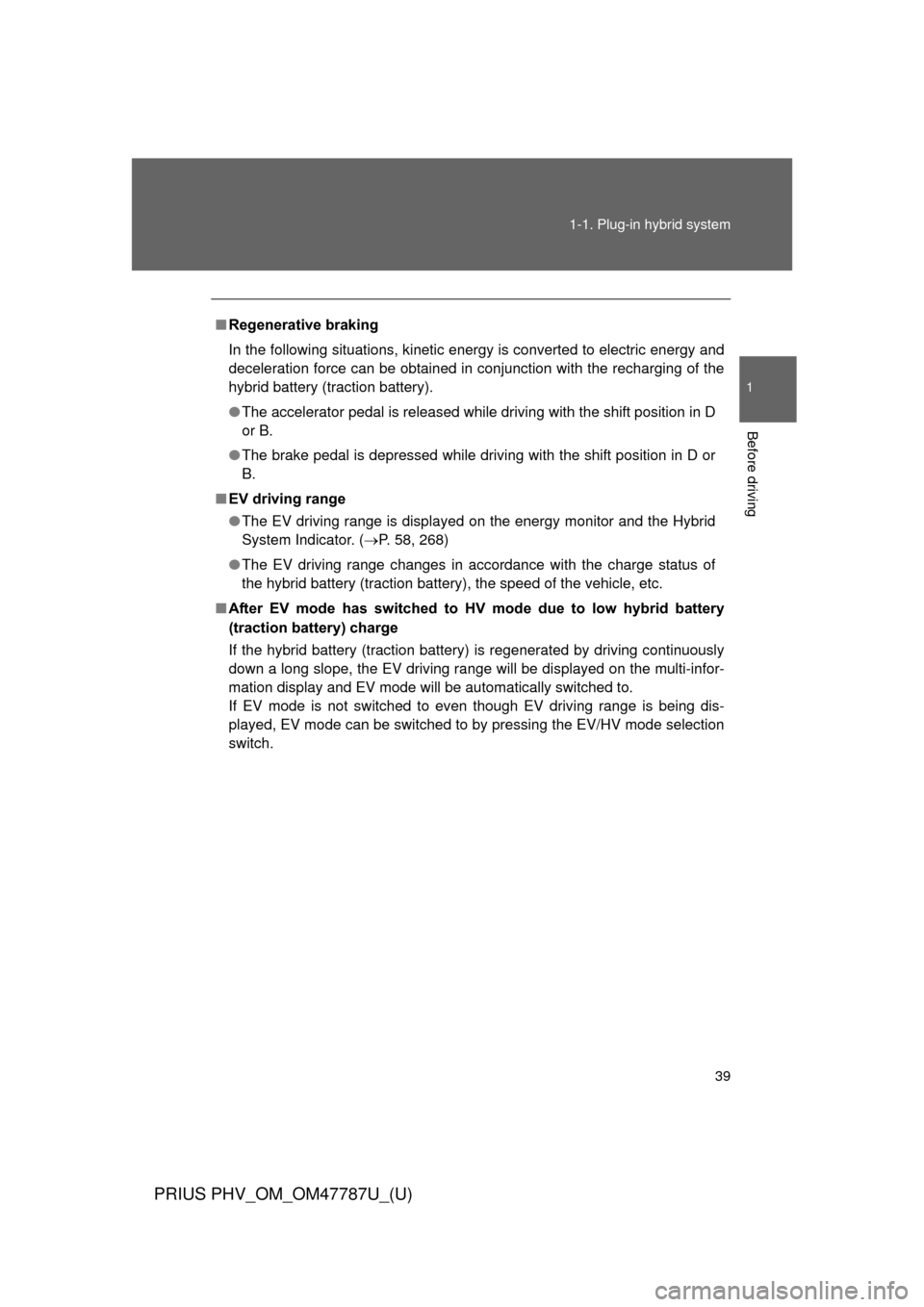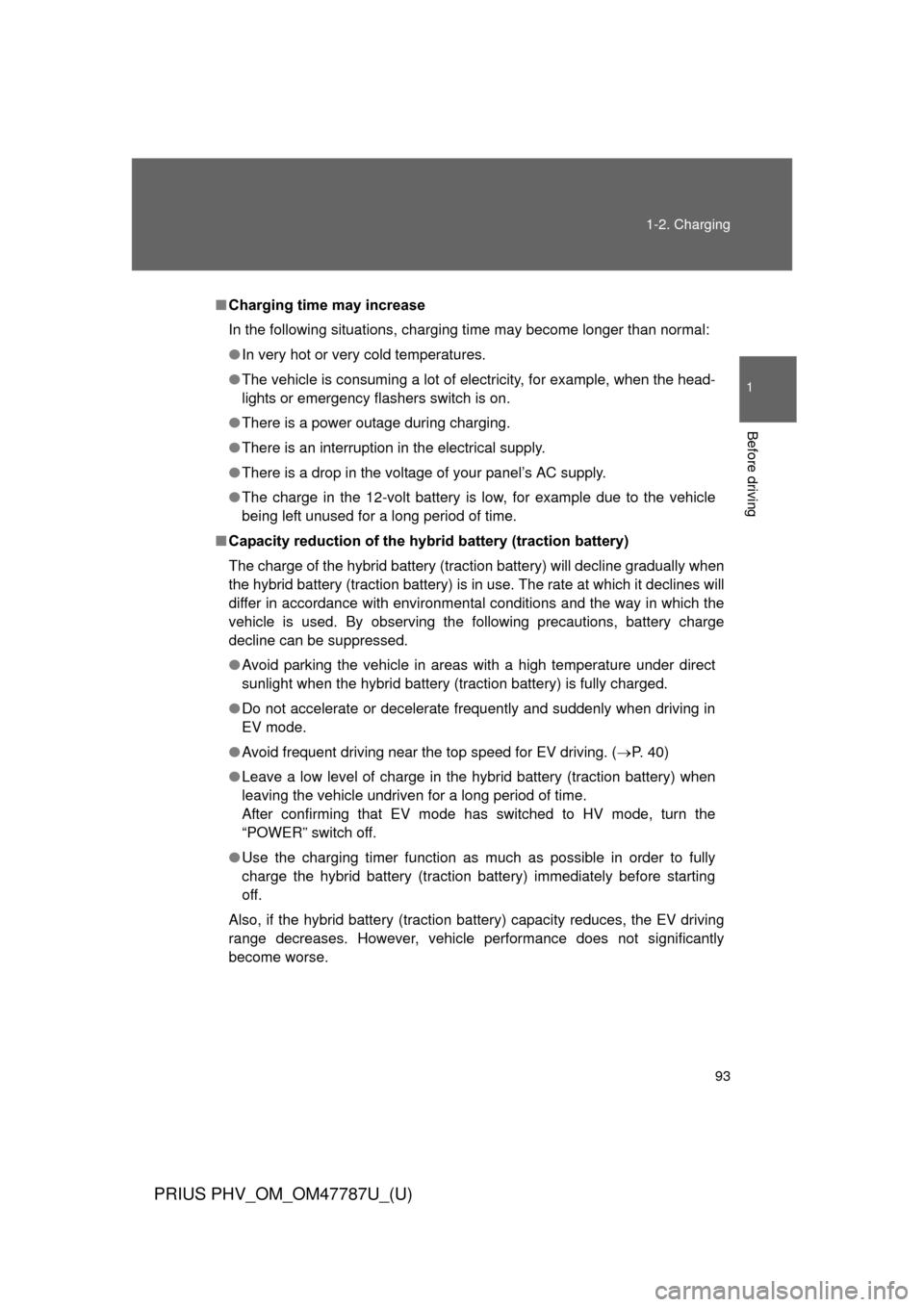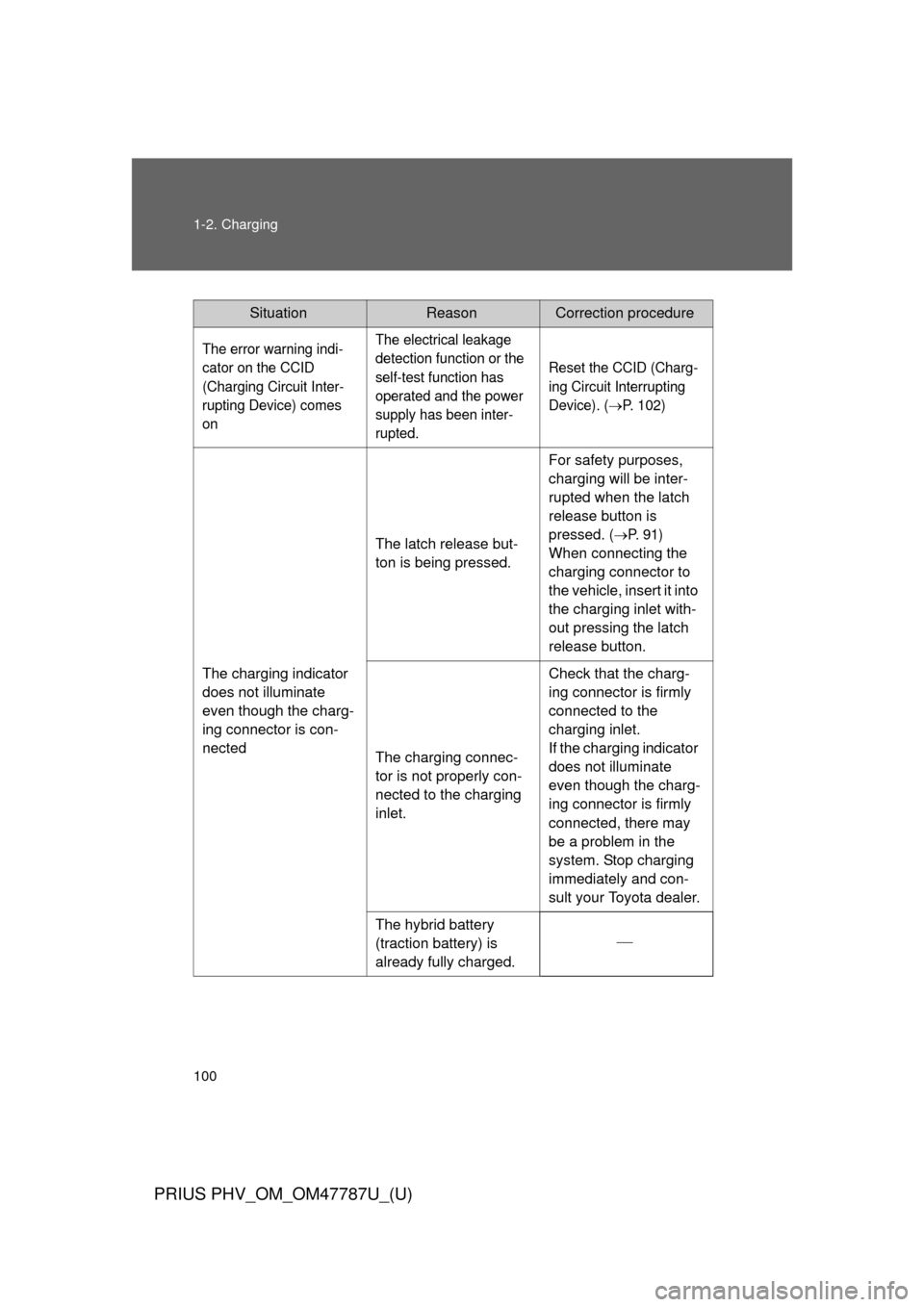Page 38 of 684
38 1-1. Plug-in hybrid system
PRIUS PHV_OM_OM47787U_(U)
Charging (P. 80)
In order to drive in EV mode,
charge the hybrid battery (trac-
tion battery) from an external
power source before using your
vehicle.
If there is not enough charge
remaining in the hybrid battery
(traction battery), the EV driving
range will become shorter.
Vehicle proximity notification system
When driving with the gasoline engine stopped, a sound, which
changes in accordance with the dr iving speed, will be played in order
to warn people nearby of the vehicle’s approach. The sound will stop
when the vehicle speed exceeds a pproximately 15 mph (25 km/h).
Page 39 of 684

39
1-1. Plug-in hybrid system
1
Before driving
PRIUS PHV_OM_OM47787U_(U)
■
Regenerative braking
In the following situations, kinetic energy is converted to electric energy and
deceleration force can be obtained in conjunction with the recharging of the
hybrid battery (traction battery).
● The accelerator pedal is released while driving with the shift position in D
or B.
● The brake pedal is depressed while driving with the shift position in D or
B.
■ EV driving range
● The EV driving range is displayed on the energy monitor and the Hybrid
System Indicator. ( P. 58, 268)
● The EV driving range changes in accordance with the charge status of
the hybrid battery (traction battery), the speed of the vehicle, etc.
■ After EV mode has switched to HV mode due to low hybrid battery
(traction battery) charge
If the hybrid battery (traction battery) is regenerated by driving continuously
down a long slope, the EV driving range will be displayed on the multi-i\
nfor-
mation display and EV mode will be automatically switched to.
If EV mode is not switched to even though EV driving range is being dis-
played, EV mode can be switched to by pressing the EV/HV mode selection
switch.
Page 41 of 684

41
1-1. Plug-in hybrid system
1
Before driving
PRIUS PHV_OM_OM47787U_(U)
■
When continually using EV mode only
After driving for approximately 124 miles (200 km) with the gasoline engine
off, the gasoline engine may start for a short amount of time in order to pro-
tect the system.
■ Conditions in which the gasoline engine may not stop
The gasoline engine starts and stops automatically. However, it may not stop
automatically in the following conditions
*:
● During gasoline engine warm-up
● When the temperature of the hybrid battery (traction battery) is high or
low
● During hybrid battery (traction battery) charging
● When the heater is switched on
*: Depending on the circumstances, the gasoline engine may also not stop
automatically in situations other than those above.
■ If the vehicle is not used for a long time
The 12-volt battery may discharge. In this event, charge the 12-volt battery.
(P. 594)
In order to prevent the hybrid battery (traction battery) from becoming
extremely low in charge, start the hybrid system at least once every 2 or 3
months, and turn the “POWER” switch off after the gasoline engine has
stopped automatically. (If the gasoline engine does not start up even after
approximately 10 seconds have passed since the “READY” indicator came
on, the “POWER” switch can be turned to OFF without any further action.)
Page 86 of 684
86 1-2. Charging
PRIUS PHV_OM_OM47787U_(U)
Charging timer functionBy using the charging timer function, deterioration of the hybrid bat-
tery (traction battery) charge can be suppressed ( P. 93), and off-
peak electricity can be used effectively.
● A charging time can be assigned by setting the charging start time
or finish time.
● Once the time has been set, the time can be assigned again next
time simply by pressing the charging timer switch.
Remove the plug from the out-
let when the charging equip-
ment will not be used for a
prolonged period of time.
Hold the body of the plug when
removing.
Make sure to put the cable
away immediately after discon-
necting. ( P. 95)
When leaving the plug
inserted, inspect the plug and
connector once a month to
check if dirt or dust has accu-
mulated.
STEP 4
Page 90 of 684

90 1-2. Charging
PRIUS PHV_OM_OM47787U_(U)
■Charging messages
The first time the “POWER”
switch is turned to ON mode
after charging is completed, a
message detailing the results of
the charging will be displayed.
Also, if an operation which can-
not be carried out is attempted
during charging, a warning mes-
sage will be displayed.
( P. 562)
Comply with the instructions in
the message and carry out any
necessary operations.
The message may not be dis-
played if the Remote Air Condi-
tioning System ( P. 371) has
been used.
■ Amount of time until charging is complete
Charging fully from an EV driving range of 0 mile (0 km) ( P. 58) will take
approximately 2.5 hours (AC120 V).
The amount of time until charging is complete will change in accordance with
the amount of charge remaining in the hybrid battery (traction battery), the
outside temperature, etc.
■ During charging
● The surface of the CCID (Charging Circuit Interrupting Device) may
become hot, but this does not indicate a malfunction.
● Depending on radio wave conditions, interference may be heard on the
radio.
Page 92 of 684

92 1-2. Charging
PRIUS PHV_OM_OM47787U_(U)
■Charging timer function (finish time setting mode)
● The finish time setting mode should only be used as a reference for the
time at which charging will finish.
Charging may not complete at the finish time depending on the effects of
the electricity supply, temperature etc. In this event, charging will continue
until completed.
● If the function detects that charging cannot be finished on time, charging
will start immediately, and will continue until fully charged.
■ Charging indicator
● The charging indicator illuminates if the Remote Air Conditioning System
(P. 371) is used during charging or while the charging cable is con-
nected.
● If a system malfunction occurs during charging or during Remote Air
Conditioning System use, the indicator will flash for approximately 10
seconds and then turn off.
■ When the outside temperature is low or high
The level shown on the remaining charge display ( P. 60) may drop slightly
when the “POWER” switch is turned to ON mode, even if charging has been
completed and the hybrid battery (traction battery) is fully charged. However,
this does not indicate a malfunction.
■ Using a DC Charger
DC Chargers cannot be used with this vehicle.
Page 93 of 684

93
1-2. Charging
1
Before driving
PRIUS PHV_OM_OM47787U_(U)
■
Charging time may increase
In the following situations, charging time may become longer than normal:
● In very hot or very cold temperatures.
● The vehicle is consuming a lot of electricity, for example, when the head-
lights or emergency flashers switch is on.
● There is a power outage during charging.
● There is an interruption in the electrical supply.
● There is a drop in the voltage of your panel’s AC supply.
● The charge in the 12-volt battery is low, for example due to the vehicle
being left unused for a long period of time.
■ Capacity reduction of the hybrid battery (traction battery)
The charge of the hybrid battery (traction battery) will decline gradually when
the hybrid battery (traction battery) is in use. The rate at which it declines will
differ in accordance with environmental conditions and the way in which the
vehicle is used. By observing the following precautions, battery charge
decline can be suppressed.
● Avoid parking the vehicle in areas with a high temperature under direct
sunlight when the hybrid battery (traction battery) is fully charged.
● Do not accelerate or decelerate frequently and suddenly when driving in
EV mode.
● Avoid frequent driving near the top speed for EV driving. ( P. 40)
● Leave a low level of charge in the hybrid battery (traction battery) when
leaving the vehicle undriven for a long period of time.
After confirming that EV mode has switched to HV mode, turn the
“POWER” switch off.
● Use the charging timer function as much as possible in order to fully
charge the hybrid battery (traction battery) immediately before starting
off.
Also, if the hybrid battery (traction battery) capacity reduces, the EV driving
range decreases. However, vehicle performance does not significantly
become worse.
Page 100 of 684

100 1-2. Charging
PRIUS PHV_OM_OM47787U_(U)
SituationReasonCorrection procedure
The error warning indi-
cator on the CCID
(Charging Circuit Inter-
rupting Device) comes
onThe electrical leakage
detection function or the
self-test function has
operated and the power
supply has been inter-
rupted.
Reset the CCID (Charg-
ing Circuit Interrupting
Device). (
P. 102)
The charging indicator
does not illuminate
even though the charg-
ing connector is con-
nectedThe latch release but-
ton is being pressed.
For safety purposes,
charging will be inter-
rupted when the latch
release button is
pressed.
(P. 9 1 )
When connecting the
charging connector to
the vehicle, insert it into
the charging inlet with-
out pressing the latch
release button.
The charging connec-
tor is not properly con-
nected to the charging
inlet. Check that the charg-
ing connector is firmly
connected to the
charging inlet.
If the charging indicator
does not illuminate
even though the charg-
ing connector is firmly
connected, there may
be a problem in the
system. Stop charging
immediately and con-
sult your Toyota dealer.
The hybrid battery
(traction battery) is
already fully charged.